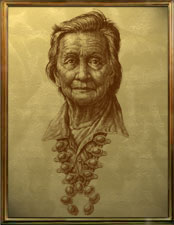|
|
|
|
Seneca

TRIBE NAME: The name Seneca is from the Iroquoian term which means "people of the standing or projecting rock or stone" derived from Onenuite'ron'no.
LANGUAGE: : Belonging to the Iroquoian linguistic family, the largest division of the Five Nations (or League of the Iroquois), who were first found living in New York.
HISTORY: Conestoga, Cayuga, Mohawk, Oneida, Tuscarora and Onondaga (driven into Ohio by early colonists) and the Seneca of Sandusky (who had lived in New York at the outset of the American Revolution). After the war, the Cayuga moved to Ohio, where they were granted a reservation along the Sandusky River. They were joined there by the Shawnee of Ohio and the rest of the confederacy. In 1831, the tribe sold their land in Ohio and accepted a reservation in the Cherokee Nation in Indian Territory.
They were a prosperous people who, preparing to leave Ohio, heavily loaded their baggage (clothing, household goods, tools, seed) onto a steamboat to sail to St. Louis. The trip to their new home took eight months plagued by delays, blizzards, floods, disease and death. Upon their arrival in Indian Territory, they found their lands overlapped those of the Cherokee. Another band (the Mixed Band of Seneca and Shawnee) also traded their Ohio lands for a tract in Indian Territory; theirs was wholly within the Cherokee Nation. An 1832 treaty, the first made by the U.S. with the immigrant Indians within the boundaries of Oklahoma, adjusted the boundaries and created the "United Nation of Seneca and Shawnee."
During the Civil War, the tribe allied with the Confederacy. Because their homeland became a battleground, eventually most fled to Kansas for safety. In 1867, federal negotiators sold part of their lands to various tribes and arranged for the separation of the Shawnee (who then became the Eastern Shawnee). In 1881, a band of Cayuga from Canada joined the Seneca tribe in Indian Territory. In 1902, shortly before Oklahoma became a state, 372 members of the joint tribe received land allotments.
LANDMARKS: The Mission of Cayuga (East of Grove); the Dobson Museum (Miami); the State Museum of History (OKC); Gilcrease and Philbrook Museums (Tulsa).
Current tribal roll: 3,465
SENECA-CAYUGA
Jerry Dilliner, Chief
Faithkeepers School - http://faithkeepersschool.com
An immersion school where Seneca children are taught the Seneca langauge and Longhouse Teachings.
Seneca Nation Library - http://www.cclslib.org/snia/snia.html
Hours, location, and contact information; also provides links on the Seneca.
Shotinontowane'haka - http://www.kahonwes.com/links1/links_seneca.htm
Links to Seneca Nation resources, from the Kahon:wes's Iroquois Confederacy Index.
The Seneca Nation of Indians - http://www.sni.org/
Official website of this Indian tribe includes information on the Reservation, Seneca Nation government and education programs, genealogy, and cultural topics.
Seneca - http://www.worldlanguage.com/Languages/Seneca.htm
Background information and a legend in the Seneca language.
Seneca Language - http://www.ohwejagehka.com/seneca/index.html
Short glossary of Seneca, with audio files for each word.
Seneca Language Discussion List - http://groups.yahoo.com/group/Seneca-Language
Open membership unmoderated e-mail listserv.
Wallace Chafe Bibliography - http://www.linguistics.ucsb.edu/people/faculty/chafe/refs.htm
The linguist's work in the Seneca language.
Iroquois History - http://www.tolatsga.org/iro.html
This overview of Haudenosaunee history includes historical information about the Mingo.
Mingo Indians - http://www.swcp.com/~dhickman/notes/mingo.html
Notes on the Mingo.
Mingo Indians of Ohio - http://www.ohiokids.org/ohc/history/h_indian/tribes/mingo.html
History of the Mingo in Ohio.
The Senecas Of The Sandusky - http://www.friendlynet.com/stevehartzell/senecas.html
Description and history of the Mingo of the Sandusky region. |
|
|
|
|
|
 Native American Nations
Native American Nations
